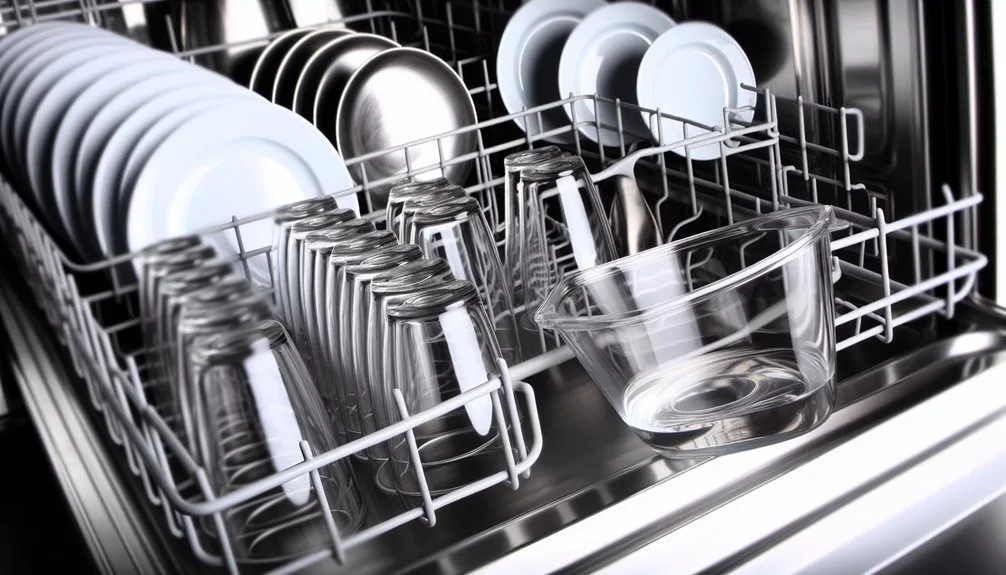To maintain your dishwasher effectively, adhere to these best practices: clean the filter monthly to prevent poor performance, inspect and clean spray arms regularly to guarantee even water distribution, and use the correct detergent to avoid residue build-up. Additionally, clear the drain often to prevent clogs, load dishes correctly to optimize cleaning, and maintain the integrity of seals to prevent leaks. Employ rinse aids to reduce water spots, run the dishwasher only when full to conserve resources, and address any operational issues promptly to avoid major repairs. Following these guidelines not only extends the lifespan of your dishwasher but also enhances its performance, further preparing you to tackle appliance care with confidence.
Clean the Filter Regularly
One often overlooked but essential step in maintaining a dishwasher is regularly cleaning its filter. Filter maintenance is vital for the appliance's efficiency and longevity. A dirty filter can lead to a host of problems, including poor cleaning performance, longer wash cycles, and even damage to the machine itself.
The cleaning frequency of your dishwasher filter depends largely on usage and the types of dishes cleaned. Typically, it's advisable to check and clean the filter monthly. However, if you notice visible food debris or an odor coming from your dishwasher, it's a sign that the filter needs immediate attention.
To clean the filter, first, remove it from the bottom of the dishwasher. Most filters can be easily unscrewed or popped out. Rinse it under hot running water and use a soft brush to remove any stuck-on food particles. For more stubborn debris, soaking the filter in warm, soapy water can be effective.
Make sure the filter is completely dry before reinstalling it. Regular filter maintenance not only guarantees peak performance but also conserves energy and water by preventing recirculation of dirt. This simple routine can extend the life of your dishwasher and keep it running efficiently.
Inspect and Clean Spray Arms
Inspecting and cleaning the spray arms is another essential step in maintaining your dishwasher's performance. Over time, food particles and mineral deposits can clog the holes in the spray arms, leading to reduced efficiency and poor cleaning results.
Regular spray arm maintenance guarantees that water is evenly distributed during cycles, optimizing your dishwasher's functionality.
To begin spray arm inspection, first verify that the dishwasher is empty and turned off. Remove the lower spray arm by gently pulling it upward; some models may require unscrewing. Hold it up to the light and look through each hole to check for blockages. If you find debris, use a small, non-metallic object like a toothpick to carefully remove it. Rinse the spray arm under warm water to dislodge any loose particles.
Repeat the process with the upper spray arm, which might be clipped in place and could require a gentle tug or release mechanism to detach.
After both arms are cleared and rinsed, securely reattach them to their respective positions, ensuring they spin freely without obstruction.
Use the Right Detergent
Selecting the appropriate detergent and using the correct dosage are critical steps in ensuring your dishwasher operates efficiently and your dishes come out clean.
Incorrect detergent types or improper amounts can lead to build-up inside the machine and cloudy, residue-laden dishes.
It is essential to follow manufacturer recommendations for detergent selection and adhere strictly to dosage guidelines to avoid these issues.
Detergent Type Selection
Choosing the appropriate detergent is vital for optimizing your dishwasher's cleaning performance and longevity. When selecting a detergent, it's important to take into account the type and quality of the ingredients. Some detergents contain harsh chemicals that can damage your dishwasher's internal components over time and leave harmful residues on your dishes.
Opting for detergents with environmentally friendly ingredients not only preserves the condition of your dishwasher but also supports global sustainability efforts. Eco-friendly options often use biodegradable compounds that reduce environmental impact without compromising cleaning power. These detergents typically avoid phosphates and chlorine, which are known to cause ecological harm. Instead, they might include natural enzymes and plant-derived surfactants that effectively break down food residues and grease.
When shopping, look for certifications like "EcoCert" or "Green Seal" to verify the product meets stringent environmental standards. Additionally, think about detergents that are specifically designed for dishwashers to prevent issues such as excessive foaming or incomplete dissolution, which can lead to poor wash results and potential machine problems.
Ultimately, the right detergent not only contributes to a cleaner environment but also enhances the efficiency and lifespan of your dishwasher, making it a key aspect of maintenance.
Detergent Dosage Guidelines
Understanding the correct amount of detergent to use in your dishwasher is vital for both the effectiveness of cleaning and the health of your appliance. Using too much detergent can lead to residue on dishes and potential damage to the machine's internal components, while too little may result in poorly cleaned dishes. It's important to strike the right balance, which depends on the hardness of your water and the type of detergent used.
Detergent concentration effects are significant. High concentrations can cause excessive suds, impairing the washing action and potentially leading to leaks. Conversely, low detergent concentrations might not dissolve and disperse food particles adequately, leaving you with unsatisfactory results.
To guarantee the best detergent usage, consider using dosage measurement tools. These tools help measure the precise amount of detergent needed per wash cycle, accounting for varying factors like load size and soil level.
Follow the manufacturer's guidelines on detergent dosage. These instructions are tailored to the design and function of your specific dishwasher model and take into account the detergent's formula. Being diligent with these recommendations will enhance your dishwasher's performance and longevity, providing spotless dishes every time.
Clear the Drain Regularly
One of the most essential steps in maintaining dishwasher efficiency is to regularly clear the drain. Confirming that the drain is free from debris not only prevents clogs but also enhances the overall performance and longevity of your appliance.
Drain maintenance is critical for avoiding unnecessary repairs and for keeping the machine running smoothly.
Here are the steps to effectively clear your dishwasher drain:
- Turn Off the Power: Safety first. Always disconnect the dishwasher from its power source before attempting any maintenance.
- Remove the Bottom Rack: Take out the bottom rack to access the dishwasher drain easily.
- Check for Debris: Examine the drain area and remove any food scraps, glass, or other objects that could block the drain and lead to clog prevention.
- Clean the Filter: Many dishwashers have a removable filter. Take it out, rinse it under running water, and scrub it with a soft brush to remove any trapped particles.
Regular drain maintenance not only prevents future problems but also guarantees that your dishwasher operates at ideal efficiency.
Neglecting this simple task can lead to poor dishwasher performance and costly repairs.
Load Dishes Properly
Proper loading of dishes is pivotal to maximizing the efficiency of your dishwasher and guaranteeing all items are thoroughly cleaned. Understanding the principles of dish placement and loading techniques is fundamental.
Start by positioning larger items like pots and pans on the bottom rack, facing downwards to avoid water pooling. Plates should be slotted vertically into the designated slots and spaced well to avoid nesting, which can block water and detergent from reaching all surfaces.
Glasses and lighter items belong on the upper rack to prevent damage from the intense spray of water below. Confirm that glasses are spaced apart to prevent clinking and potential breakage.
Utensils should be mixed in the silverware basket, with some handles up and others down to enhance cleaning effectiveness and minimize the risk of nesting.
Lastly, avoid overloading. An overcrowded dishwasher can lead to poorly cleaned dishes and increased cycles, which is inefficient and wastes energy. Each dish should have enough space for water and detergent to circulate around it, guaranteeing a thorough clean.
Correct dish placement and loading techniques not only improve cleaning outcomes but also extend the lifespan of your dishwasher by preventing unnecessary strain and potential malfunctions.
Perform Monthly Deep Cleans
To guarantee ideal performance and longevity of your dishwasher, it's essential to perform monthly deep cleans.
Begin by selecting an appropriate cleaner, which can greatly affect the efficacy of the cleaning process.
Additionally, it is important to inspect the spinning arms for blockages or damage, as these are critical for evenly distributing water during a cycle.
Choose the Right Cleaner
Selecting an appropriate dishwasher cleaner is vital for performing effective monthly deep cleans.
Using the right cleaner not only enhances the efficiency of your dishwasher but also extends its lifespan by preventing the buildup of limescale and grease.
It's important to choose cleaners that are specifically designed for dishwashers to avoid any damage to its components.
Here are four key considerations when selecting a dishwasher cleaner:
- Compatibility with Your Dishwasher: Verify the cleaner is suitable for your model. Some cleaners are formulated for specific types of dishwashers and might not be effective or could even harm other models.
- Eco-Friendly Options: Opt for eco-friendly cleaners that are less harmful to the environment. These options often use naturally derived ingredients that are biodegradable.
- Effectiveness Against Grease and Limescale: Choose a cleaner that specifically targets grease and limescale, which are common issues in dishwashers.
- Cleaner Alternatives: Consider using vinegar or baking soda as natural cleaning alternatives for your monthly deep cleans.
These substances can effectively remove odors and residues without the use of harsh chemicals.
Inspect Spinning Arms
Inspecting the spinning arms of your dishwasher should be an integral part of your monthly deep cleaning routine. These components are essential for guaranteeing your dishwasher operates efficiently and your dishes come out clean.
Over time, the spinning arms can become clogged with food particles, mineral deposits from hard water, and other debris that can hinder their movement and spray capabilities.
To begin spinning arm maintenance, verify the dishwasher is empty and turned off. Carefully remove the arms, which usually snap off or can be unscrewed.
Check for visible signs of blockage in the spray holes. Common issues include accumulated gunk that can be gently removed with a toothpick or a small brush. Rinse them under water to confirm they are completely clean.
It is also important to inspect for any wear or damage on the spinning arms. Look for cracks or splits, which can impact water flow and distribution. If damage is noted, replace the arms to prevent further problems.
Reattach the arms securely and run a short cycle to test their functionality.
Regular maintenance of the spinning arms will prolong the life of your dishwasher and enhance its performance, guaranteeing spotlessly clean dishes every cycle.
Check and Maintain Seals
Maintaining the integrity of your dishwasher's seals is vital for ideal performance and preventing water leaks. The seals, important components situated around the door and possibly underneath, guarantee that water remains inside the unit during operation.
Knowing the different seal types and how to maintain them can greatly extend the life of your appliance and prevent costly repairs.
Here is a step-by-step guide to maintaining your dishwasher's seals:
- Inspect Regularly: Check the seals every few months for signs of wear or damage like cracks or looseness. Catching issues early prevents water leakage and more severe damage to the dishwasher's internal components.
- Clean Gently: Use a soft cloth dampened with warm soapy water to wipe down the seals. This removes food particles and grease that can degrade the seal material over time.
- Avoid Harsh Chemicals: Do not use bleach or other harsh cleaners that can prematurely wear out the seal material. Stick to mild detergents and rinse thoroughly.
- Replace if Necessary: If seals are significantly damaged—or if you notice consistent moisture outside the dishwasher—it's time to replace them. Consult your dishwasher's manual for guidance on obtaining the correct seal types and replacement procedures.
Use Rinse Aid for Spotless Results
Using rinse aid is an effective strategy to enhance drying efficiency and prevent water spots on your dishes after a wash cycle. Rinse aids work by lowering the surface tension of water, which promotes quicker drying and minimizes the marks left by droplets. This is vital, especially in areas with hard water, as it can lead to significant mineral deposits on dishes and glassware.
| Benefit | Description | Suitable for |
|---|---|---|
| Enhanced Drying | Speeds up the drying process, avoiding spots | All types of dishwashers |
| Spot Prevention | Reduces water marks and streaks | Glassware and shiny items |
| Improved Dish Appearance | Glasses and plates appear cleaner and shinier | Homes and restaurants |
| Cost-effective | Small amounts needed per cycle | Budget-conscious households |
For those seeking rinse aid alternatives due to allergies or preferences for natural solutions, consider vinegar or citric acid. These natural acids help break down residues and are gentle on the environment. However, always verify with your dishwasher's manufacturer before using alternatives to confirm compatibility and prevent damage. Using rinse aids or their alternatives can greatly improve the performance of your dishwasher, guaranteeing impeccable results with each cycle.
Run Full Loads Only
To enhance the longevity and efficiency of your dishwasher, it is advisable to run it only when fully loaded.
This practice not only maximizes energy efficiency by ensuring that the maximum amount of dishes are cleaned per energy spent but also helps in reducing wear and tear on the machine's components.
Additionally, running full loads conserves significant amounts of water, aligning with environmentally friendly practices.
Maximizing Energy Efficiency
One effective method to boost your dishwasher's energy efficiency is by running full loads only. This practice guarantees that you are making the most out of the water and energy consumed during each wash cycle.
By waiting until you have a full load, you can greatly reduce the number of cycles you run annually, thereby conserving both resources and reducing your utility bills.
When aiming to maximize energy efficiency in your dishwasher usage, consider the following practices:
- Utilize Energy Saving Settings: Most modern dishwashers come equipped with energy-saving settings or eco-friendly cycles designed to minimize water usage and lower energy consumption.
- Avoid Pre-Rinsing Dishes: Skip pre-rinsing dishes before loading them. Modern dishwashers can handle bits of food, and skipping this step can save considerable amounts of water.
- Air Dry Option: Use the air-dry feature instead of the heat-dry setting. This reduces energy usage by allowing dishes to dry naturally without the use of additional heating.
- Load Efficiently: Arrange dishes in a manner that maximizes space and allows water to circulate freely, guaranteeing all items are cleaned effectively without the need for repeat cycles.
Adopting these strategies can lead to substantial energy savings and a reduced environmental footprint.
Reducing Wear and Tear
Running your dishwasher only when fully loaded not only enhances energy efficiency, as previously discussed, but also plays an important role in reducing wear and tear on the appliance. This practice is a vital aspect of preventative maintenance that contributes greatly to appliance longevity. Each cycle a dishwasher runs involves mechanical motion, water flow, and detergent usage, which gradually stresses its components.
By limiting the number of cycles to only necessary full loads, you reduce the frequency of stress, thereby extending the life of the machine. When you operate your dishwasher less frequently, you also minimize the potential for breakdowns and the need for costly repairs or replacements.
Consider this: every unnecessary cycle is an opportunity for parts to wear out or malfunction. By maximizing each wash with a full load, you guarantee that the appliance operates under ideal conditions. This efficiency not only preserves the mechanical integrity of your dishwasher but also assures it performs effectively for a longer period.
This approach to running your dishwasher underscores the importance of thoughtful usage patterns as part of routine appliance care. By adopting such habits, you contribute to the sustainable operation of your household appliances, guaranteeing they serve you well without frequent issues or disruptions.
Conserving Water Usage
Conserving water is a critical aspect of sustainable home management, and utilizing your dishwasher at full capacity is a straightforward yet effective strategy.
Running your dishwasher only when it's fully loaded can greatly reduce the amount of water used, aligning with both water saving techniques and eco-friendly practices.
Here are specific ways to enhance your dishwasher use:
- Wait for Full Loads: Resist the urge to run the dishwasher when it's partially filled. Waiting until it's completely full maximizes efficiency and conserves water.
- Scrape, Don't Rinse: Pre-rinsing dishes under running water before loading them wastes a substantial amount of water. Simply scrape off food remnants; modern dishwashers can handle the rest.
- Load Efficiently: Properly arranging dishes can allow you to fit more into each load. Consult your dishwasher's manual for loading recommendations to guarantee ideal cleaning and space utilization.
- Choose Eco-Friendly Cycles: Many dishwashers have eco-friendly cycle options designed to use less water and energy. Utilizing these settings for full loads contributes further to water conservation.
Address Issues Promptly
When you notice any irregularities in your dishwasher's performance, addressing these issues promptly is essential to prevent further complications. Early detection of problems not only saves time and money but also extends the lifespan of your appliance. This proactive approach is a critical component of effective dishwasher troubleshooting.
Maintaining a regular maintenance schedule allows you to catch issues before they escalate into major repairs. For instance, you might notice the dishwasher making unusual noises or failing to clean dishes properly.
These could be signs of a clogged spray arm or a malfunctioning pump. Ignoring such symptoms can lead to more severe problems, like water leaks that might damage your kitchen flooring or cabinets.
It's important to consult your dishwasher's manual for specific troubleshooting steps and to understand the manufacturer's recommendations for routine maintenance.
If you're unable to resolve the issue yourself, don't hesitate to call a professional technician. Delaying repairs can often compound the problem, resulting in costly fixes or even the need for a complete replacement.
Frequently Asked Questions
How Often Should I Replace My Dishwasher's Water Inlet Valve?
To guarantee peak functionality, the water inlet valve in your dishwasher should generally be replaced every 5 to 7 years. Adhering to this valve replacement frequency aids in maintaining efficient water inlet maintenance.
What Is the Average Lifespan of a Modern Dishwasher?
The average lifespan of a modern dishwasher typically ranges from 7 to 12 years. Regular maintenance, such as cleaning filters and inspecting seals, can enhance dishwasher longevity and guarantee peak performance throughout its life.
Can I Use Baking Soda as a Cleaning Agent in My Dishwasher?
Yes, baking soda can be used as a cleaning agent in your dishwasher. Its mild abrasive qualities and deodorizing properties enhance cleaning, offering a natural, cost-effective alternative to chemical-based products.
How Can I Prevent Odors in My Dishwasher?
To prevent odors in your dishwasher, regularly clean filters and seals, use a vinegar rinse, and guarantee dishes are food-free before loading. Consistent maintenance and monthly deep cleaning are essential for effective odor elimination.
Is It Safe to Wash Plastic Containers in the Dishwasher?
Washing plastic containers in a dishwasher is generally safe, much like traversing a familiar road, as long as you verify the plastic type. Check for dishwasher-safe labels to guarantee compatibility and avoid damage.



